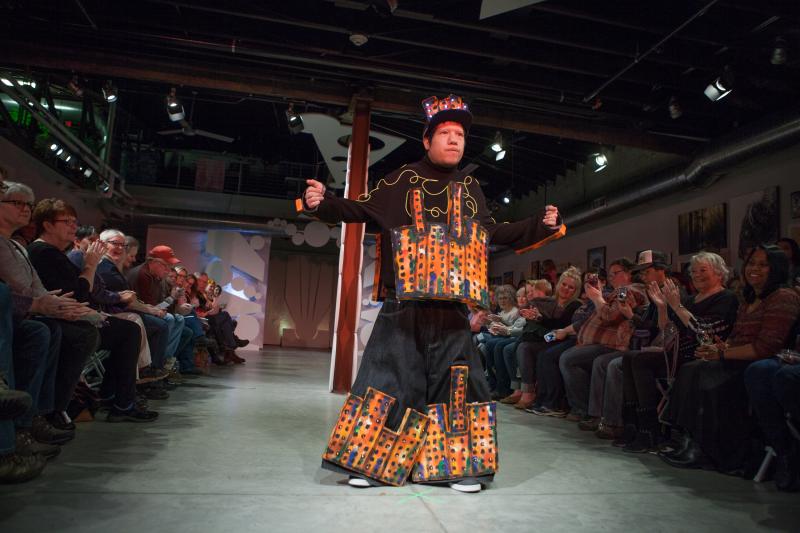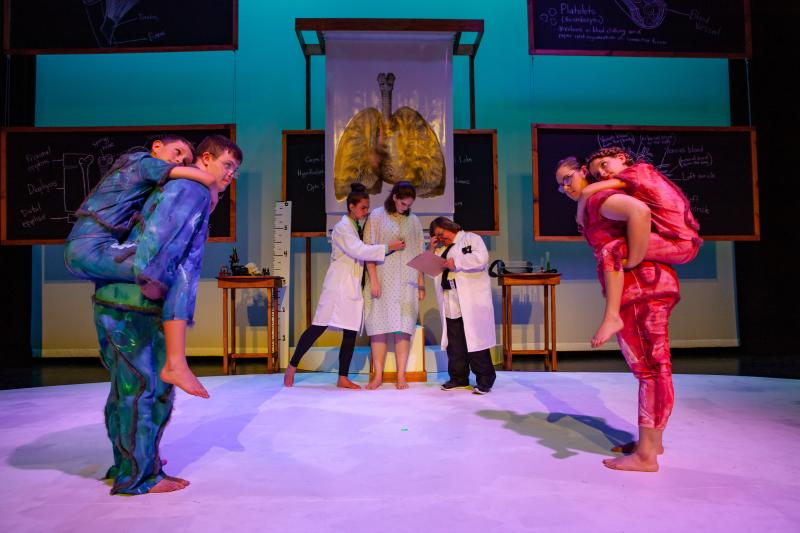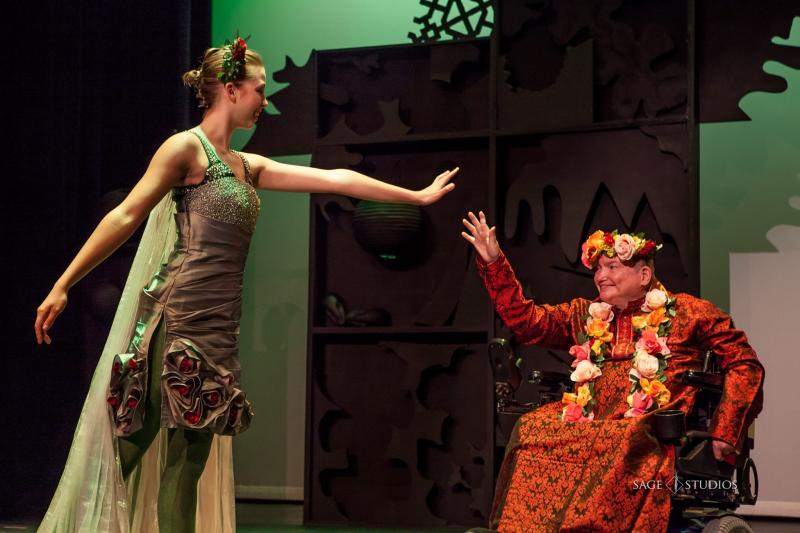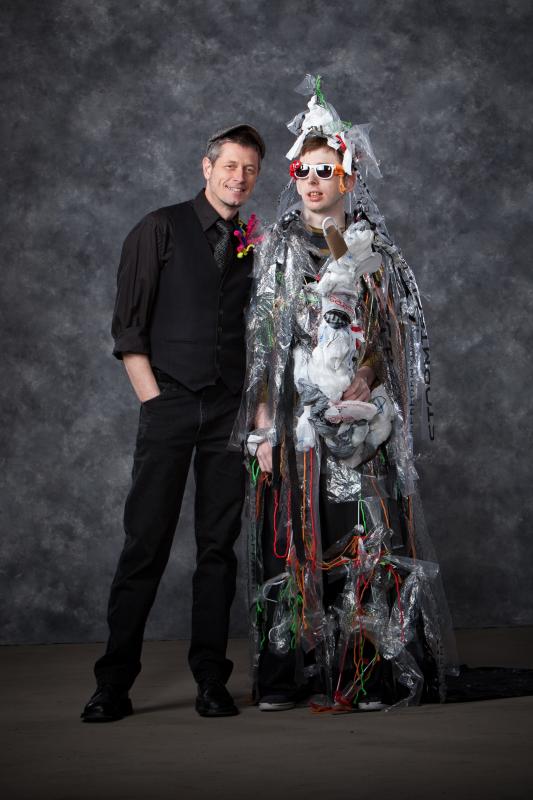Grant Spotlight: Black Hills Works and Flutter Productions

Designer Tommy Tamayo poses on the runway in his “Buildings” design for FashionABLE in 2017 that he built with community volunteer Marguerite Reyelts. Photo by Russell Jensen of Sage Studios
In 1958, a small group of determined parents in Rapid City, South Dakota, embarked on a journey to lay the foundation for what would become Black Hills Works, an organization that offers a wide array of opportunities aimed at maximizing the independence and fullness of life for adults with intellectual disabilities. Kristina Roth, grants officer at Black Hills Works, said “They knew their children deserved to grow up at home with their families and be part of their local communities. Rather than send them to live at an institution on the other side of the state to be raised by strangers, they established a school and developed vocational training for young adults.” What began as a small initiative evolved into a thriving organization that now supports 600 individuals. Rooted in a person-centered approach, Black Hills Works has become a beacon of inclusivity, providing diverse residential options, employment support, and social enterprises. In 2015, Flutter Productions, an all-ability theater and contemporary dance company, became a division of Black Hills Works.
Flutter Productions Founder and Artistic Director Heather Pickering said “We create opportunities for performers of all-abilities to soar, challenging the perception of people with disabilities and creating a new creative community in which performers—with and without disabilities—come together to celebrate the human spirit. Through Flutter Productions, many have become writers, performers, designers, and crafts people. They have a stage, microphone, runway, or art gallery in which to share and showcase their experiences, perspectives, and voices with our larger community.”
This month, Black Hills Works and Flutter Productions received an Arts Endowment grant to support the work of FashionABLE: All-Ability Threads, a biennial, multidisciplinary production featuring fashion designs that are created and modeled by adults with intellectual and developmental disabilities.
Roth and Pickering spoke with us about the goals for the upcoming FashionABLE: All-Ability Threads production and the power of art in fostering creativity, inclusivity, and individual empowerment for everyone.
NEA: Could you share more about what Black Hills Works does?
KRISTINA ROTH: Black Hills Works provides an extensive range of opportunities to ensure adults with intellectual disabilities live as independently and as fully as possible. As a person-centered agency, their needs and goals drive everything we do. We have over 30 residential options in the community adapted to individual preferences, including small group homes, supported studio apartments, shared living host families, and independent apartments. Our employment support team pairs individuals with area businesses and organizations for a variety of job placements. These include custodial and customer service teams at Ellsworth Air Force Base, Mount Rushmore, Crazy Horse Memorial, and individual placements at small businesses. We offer training and employment in our social enterprises, including the Suzie Cappa Art Center, auto detailing, and electronics recycling. Importantly, we also provide transportation, medical support services, and day activities. We nurture physical health through an active Special Olympics delegation of 200 athletes!
Flutter Productions currently provides four classes a week: Introduction to Creative Writing, Introduction to Design, Introduction to Acting, and Creative Movement/Dance. Our classes are offered five days a week to those that are supported by Black Hills Works. In addition to classes, Flutter produces two to three all-ability creative projects or performances a year.

Performers (left to right) Henry Olivier, Zackery Wilson, Keeza Leavens, Alie Martin, Kary Moffitt, Rachel Grant, and Brooklyn Ewing perform on stage in Flutter Productions: CoRPoREAL in 2019. The performers are wearing costumes designed and hand painted by fellow cast member Shawn Stratton. Photo by Russell Jensen of Sage Studios
NEA: Black Hills Works’ mission statement is “to create an inclusive community where all participate to achieve a life of full potential.” How do the arts serve as an effective vehicle in helping people with disabilities cultivate their talents and contribute to their communities in a creative and meaningful way?
HEATHER PICKERING: We know that one marker of a successful and vibrant community is the presence of the arts. Likewise, the opportunity for creative self-expression has incalculable benefits for overall intellectual and physical health. In our experience, when individuals who have been traditionally disenfranchised or marginalized by society are shown that their perspective is of value, it has a ripple effect in their lives and the community. Their confidence grows, leading to more relationships and involvement. Through our arts programming, individuals with disabilities become visible and participate in the overall fabric that we weave together as a society with our collective histories.
Along with that, the arts have allowed individuals the opportunity to gain and work on skills that expand their reference points and experiences. Arts participation has empowered individuals to take steps in new directions they would not have previously traveled. Some individuals with disabilities (but not all) have repeatedly heard “no,” “not able,” and, “never be able.” Many may have grown up in contained environments where they spent their days primarily with other individuals with disabilities and paid staff. Our goal is to help people see new possibilities and hear words like “yes” and “able” and to be infused into a diverse population of creatives who are not paid staff.
NEA: Can you provide us with an overview of Flutter Productions and the need in the community that launched its creation?
PICKERING: We often talk about how the arts are a mirror for society, but the arts often cut out and cultivate who can be a part of that reflection, and often decide who can hold the mirror at the very highest levels. If the arts are meant to be a reflection, why not reflect and include everyone? I founded Flutter Productions in 2008 with an original production appropriately entitled Flutter, produced by Black Hills Community Theatre and Suzie Cappa Art Center, with funding by the NEA and the Allied Arts Fund. A few years earlier, Dr. Ron Reed produced an all-ability production of Oklahoma! in our city. Dr. Reed's daughter Kathy is supported at Black Hills Works. Many people with disabilities wanted to perform and be onstage more often—they just needed the opportunity. Flutter productions provided this opportunity!
The inspiration for our name came from a collage in Suzie Cappa Art Center. Butterflies popped off the canvas with the phrase, “Diversity creates dimension in this world.” Flutter was the first original, all-ability piece of dance theater created in the state of South Dakota. The experience illustrated the transformative power of the arts both on stage and behind the scenes.

Performers Sarah Powers as the Cicada (left) and “JJ” James Janis as the Sun (right) reach for each other as they perform on stage in Flutter Productions' OSITY in 2016.
NEA: What inspired you to create the FashionABLE: All-Ability Threads productions?
PICKERING: Many of the artists at Suzie Cappa Art Center also regularly participate in productions with Flutter Productions. In 2015, Flutter began offering creative design classes. We explored costume design and did introductory projects on paper. The opportunity to do a collaboration between a creative design class at Flutter and Suzie Cappa Art Center led to the idea of a fashion show. Individuals could take their art form off of the walls and onto the runway! While many of the designers in the first show were artists from Suzie Cappa, the doors were open for other individuals to apply as well. Our first fashion show was held during a Suzie Cappa monthly art night and was free to the public. We expected 50 to 60 people to attend at the most, but over 300 people flooded the gallery that night! We even had people gathered around the security camera monitors behind the front desk watching the show from the other room. In the audience was one of the owners of Jolly Lane Greenhouse, who immediately extended an invitation for Flutter to bring the show there for its larger space. The way that our designers grew and glowed from the experience, and the way that the public supported us, was an indicator that the project needed to continue.
NEA: Can you give us a snapshot of what the upcoming FashionABLE: All-Ability Threads production entails?
PICKERING: Our upcoming production is the largest to date, featuring 26 designers who have been partnered one-on-one with a community volunteer. It is never just about creating an article of clothing. It is a learning experience for many of the designers and volunteers. While all of our designers have amazing ideas, they may not always have the skills or experience to bring the idea off the page. But we don’t let a lack of skills or knowledge stop an idea from coming to life. Each team’s process to create their idea is different and scaffolded based upon their experience. Some teams can sew, while other teams feel more comfortable with a paint brush and a hot glue gun. One designer in particular has always wanted to participate, but felt as if their struggle to hold a pencil or a paintbrush precluded their participation. During classes, we have explained that one can still be a designer by articulating their idea to another individual who can assist them. The overall goal is to help people realize their ideas can be brought to life, shared with an audience, and valued by the community that they live in. As they are partnered with a volunteer community member who is not typically part of their everyday life, the hope is that our teams cultivate natural relationships that potentially extend beyond the project.

FashionABLE 2017, community volunteer Chris Shreves (left) and designer Paul Tanner (right), pose for the camera before taking the runway to show Paul’s outfit, “Garbage Bag.” Photo by Russell Jensen of Sage Studios
NEA: The FashionABLE designers are not asked to put their disability at the center of the design or to design something to reflect disability culture.
PICKERING: We have never placed limits on what FashionABLE designers can explore or asked them to design on a theme. Every human being is multifaceted. Having a disability is only one part of who they are; it doesn’t define them. While identifiers cannot be separated from a person and do provide a lens through which we see and experience the world, there is so much more to a person than the labels society wants to attach to them. Instead, we encourage designers to focus on topics that fire up their creative juices. Just like participants in any arts program, designers are encouraged to explore their creativity, statements that they would like to make, or the things that bring them joy. The end result is a multifarious, high-energy evening of color and exuberant ideas that leaves the audience and designers full of joy and inspiration.
NEA: What are other ways in which Flutter Productions engages with the community?
PICKERING: Flutter Productions created the first all-ability touring production in the state of South Dakota entitled ABLE: The Disability Chronicles. Through the production, we explored disabilities and disability culture from an educational perspective that also explored the common humanity of all individuals. Part of our goal was to connect with future health, legal, education, arts, and social work professionals in order to open up their definition of what art is and can be, and to encourage them to take the time to really listen to the needs of everyone that they encounter. Through our creative writing classes, we also produced a book written by one of our performers, “JJ” James Janis, entitled The Chair Is Not Me, which was illustrated by a cadre of diversely abled artists at Suzie Cappa Art Center. This became a touring art and poetry show that has been shown across the state of South Dakota.
NEA: In 2023, Flutter Productions celebrated its 15th anniversary. As you reflect over the organization’s milestones, what significant moments of impact has the organization made throughout the years with the participants, community, and audience members?
PICKERING: Since our founding in 2008, dozens of individuals with disabilities, hundreds of community volunteers, and thousands of audience members have experienced empowering and beautiful all-ability theater. Relationships have been built, community has been strengthened, and misconceptions overcome. FashionABLE is typically sold out, and our summer 2023 production saw 700 audience members. A poetry reading by two of our performers at the state arts conference left the room speechless and teary-eyed. South Dakota Public Television has featured us in several pieces. We are astounded by the impact that we have had in our city of 75,000 and across the state and even the nation. The first night of every rehearsal, we begin by presenting “The Ten Commandments of Communicating with Individuals with Disabilities,” guidelines on how to write about or talk to individuals with disabilities, and tips on relationship creating. This information has prompted individuals to reexamine how they approach their employees or co-workers with disabilities and led to increased employee retention. It has also led to additional job opportunities in our community for those with disabilities. Other local theater companies have opened the doors to including individuals with disabilities after watching several of our shows.
Recently, one participant who was initially presented to us as non-verbal has started to speak after attending regular acting, writing, design, and movement classes for four months! Experiences like this are life changing. Participants have the opportunity to help write the scripts for our original productions. This is often healing for them, as was the case for Ordean Stevenson. Ordean lived in the state institution from 20 months old until almost 30 years old. He moved to Black Hills Works in 1975, where he lives independently in the community, worked full-time before retirement, and performs with Flutter. The difference between his life now at nearly 80 years old and his childhood is so heartwarming.




